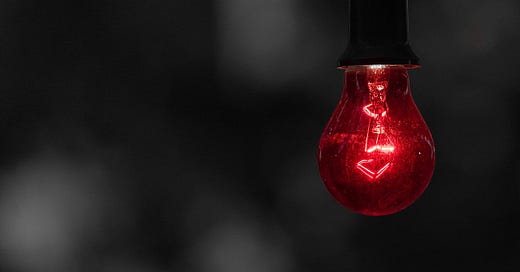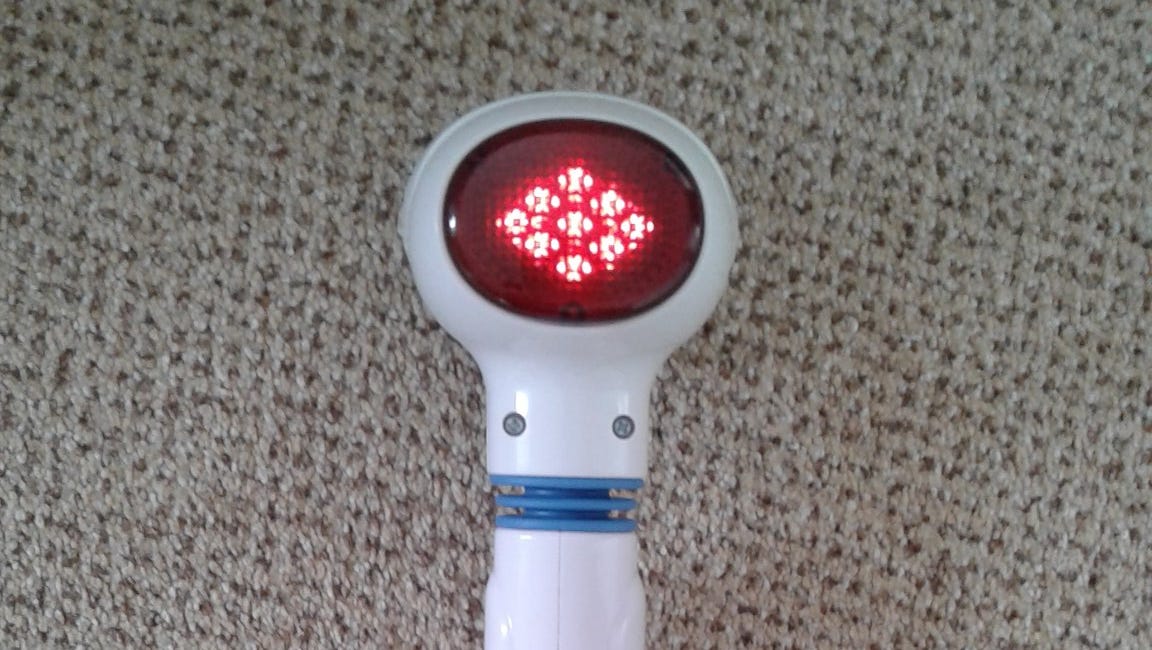Red Light and Infrared Therapies for Physical Healing. Part 2: How it Works and Other Insights
The Research Supporting Low Level Red Light Therapy
Introduction
In the first part, I did a “show and tell” of all the ways that low level red light or near infrared therapies had helped me over the years, as well as my findings that these types of therapies can be very “dose dependent” - a little can go a long way, while too much can backfire and be detrimental:
Red Light and Infrared Therapies for Physical Healing. Part 1: Self-Experiments and Personal Experiences
Introduction I have been re-sharing some facebook posts, which I wrote a while back on the topic of low level red light therapy, to Substack’s “Notes”, As these posts on this topic have proven quite popular there, I thought it would be worth gathering everything I had written on the subject here into main Substack articles.
In this second part, we get more scientific, and look at the research behind red light therapies, how it works, including why it is so dose and person specific. Then in Part 3, we will cover the conditions and illnesses for it has been scientifically proven beneficial for.
Recall from Part 1, that one of the motivating factors behind collating this information is:
“… the need to build alternative, independent systems to withstand the oncoming dystopia… will include the need for self-applicable healing modalities when we can no longer rely on healthcare systems or professionals - red light therapy could definitely be a possible important contributor to a more systematic approach to health and healing.”
The Role of Free Radicals
This is based on the scientific article: "Mechanisms and applications of the anti-inflammatory effects of photobiomodulation*" (2017)
*[Photobiomodulation (PBM) “is also known as low-level level laser therapy is the use of red and near-infrared light to stimulate healing, relieve pain, and reduce inflammation.”]
“The most popular theory to explain exactly why it works is light absorption by the mitochondria [the engine of cells] leads to increase of the enzyme activity, increased oxygen consumption, and increased ATP [energy storage chemical] production. Red light/near infrared seem optimal as these longer wavelengths have much better tissue penetration than say blue or green light which are better absorbed by hemoglobin.”
When red light/near infrared stimulates activity in normal healthy cells, the resulting increase in mitochondrial [the cells' battery] potential above normal baseline levels, leads to a brief and rather modest increase in generation of reactive oxygen species (ROS) ["free radicals"] and increase in cellular ATP [chemical energy for cells] results. Both ROS and ATP production are found to be very "biphasic", depending strongly on the intensity, proximity of the light source, the area over which the red light is applied, and the time over which it is applied.
It is important to note that while "free radicals" are often seen as universally bad, small concentrations of them are now known to be beneficial in processes called "redox signalling" - they tell other cells to become active and switch on the healing and anti-inflammatory modes.
One intriguing possibility as to when the ROS generated by red light therapy is beneficial or detrimental may depend on the rate at which they are generated. Indeed, notwithstanding, the ability of red light to produce a burst of ROS in normal cells, it is well-accepted that as a treatment for tissue injury or muscle damage it is able to reduce markers of oxidative stress. Studies indicate that low doses of the light may actually have a dual role, depending on whether a cell is an normal state or is already oxidatively stressed. In the former it increased ROS, to initially beneficial levels, but in the latter it appears to reduce the amount of free radicals.
This dose dependency, between benefit and detriment, and different responses of healthy compared to "activated" cells, helps explain why we saw such a wide variation of responses in the “citizen science” user trials of Jolie Parker’s wearable wristbands as the delivery mechanism (see Part 1).
For example, very healthy people and those on extremely high dosages of anti-oxidants, did not seem to feel the benefit or effect of the red light bracelet, even when worn for hours. A better response was found with Jolie’s white light headband in these cases [higher intensity, over a much wider area]. This is probably since the wristbands cannot produce ROS fast enough before the system or anti-oxidants mop them up in such folks.
On the other hand, people with chronic illness and hence high inflammation [i.e. those of us with cells which are already under significant oxidative stress - lots of free radicals already floating around the system] generally found that just a few minutes of the red light wristbands are enough to see some long term healing/anti-inflammatory effect, presumably due to the initial ROS reduction in our already stressed cells - but above a very limited dosing, we tended to experience increased symptoms/brain fog, either directly or within 24 hours. Overstimulation is also a possibily we've saw, disrupting already broken circadian rhythms by too high dosage, causing insomnia.
For the majority of folks in between, reports were very wide ranging, and hence personal tuning of timing seems paramount to obtain best results. It seems red light therapy is far from a "one size fits all" solution, but does offer benefits for most if tailored appropriately!
Personally, I found just 4 minutes of the wristband daily optimal, to get some energy boost during the day, and to see long term continual benefits, which are most apparent in the clearing up of skin problems, reduced dandruff, decreased signs of candida etc. Much more than this, then I started seeing side effects [increased symptoms] towards evening time. Even at 4 minutes each morning, I occasionally needed a day or two off for my system to catch up or to swap wrists, as I start feeling a gripe in the wrist I'm wearing it on - presumably due to the build up of toxins being released.
The Role of Water
The below quote is from the article on photobiomodulation cited above. The authors also provide an additional mechanism, based on Prof. Gerald Pollack’s groundbreaking work on the 4th Phase of Water. If you are not yet familiar with Pollack’s work, I highly recommend giving the short presentation below a watch to get up to speed:
“Water is by the far the most prevalent molecule in biological tissue (particularly considering its low molecule weight = 18). At present the proposed mechanism involves selective absorption of red light/NIR by structured water layers [also known as interfacial water, charge separated water, or "EZ" water - see Pollack’s lab website for the scientific details] at power levels that are insufficient to cause any detectable bulk-heating of the tissue. A small increase in vibrational energy by a water cluster formed in or on a sensitive protein could be sufficient to perturb the structure thus changing its function.”
“Pollack has shown that interfacial water can undergo charge separation when it absorbs visible or NIR light. This charge separation (equivalent to localized pH changes) could affect the folding of proteins. It has also been suggested red light/NIR could reduce the viscosity of interfacial water within the mitochondria, and it run faster as a nanomotor.”
Pollack himself provides another mechanism by which these types of therapies work, namely that they improve the microcirculation, ensuring tissues are better oxygenated. The following quotes are from his book “The 4th Phase of Water” (which I highly recommend), with my annotations in the square brackets.
“We also saw exclusion zones (EZs)...”
[EZ are negatively charged liquid crystalline layers of water, somewhere between liquid and ice, which form next to hydrophilic surfaces through separation from positively charged bulk water under the action of light, creating a battery effect in which the light energy becomes stored, and can then be used for work, such as driving motion and flow]
“...next to natural biological surfaces, including vascular endothelia (the insides of blood vessels), plant roots and muscles. A plausible process is driving of blood through capillaries...”
[capillaries are small blood vessels from 5 to 10 micrometres (µm) in diameter, and having a wall one endothelial cell thick, which convey blood between the small-diameter blood vessel in the microcirculation]
“We've experimentally proven that light drives flow through hydrophilic tubes...”
[this is flow in a tube without the usual requirement of pressure changes along the tube required to force flow ... here the work is done is by conversion of light energy, rather than standard pressure differentials]
“... in similar fashion, light could propel flow through superficial capillaries, which are merely hydrophilic tubes. Plenty of light penetrates into you body to do the job... the penetration of light into your body could plausibly drive capillary flow”
[very important since these microvessels exchange many substances with the interstitial fluid surrounding them: water , oxygen, and glucose exit the capillaries; water, carbon dioxide, uric acid, lactic acid, urea and creatinine enter, while lymph capillaries connect with larger lymph vessels to drain lymphatic fluid collected in the microcirculation]
“Blood flow can use all the help it can get. Red blood cells can be larger than the capillaries through which they pass. The red cells demonstrably contort as they pass: pushing them through requires substantial pressure, even with low friction. But routine measurements show almost no pressure drop across the capillary bed, most of the drop occurs before, in the larger arterioles. Thus, capillaries do not behave as the high-resistance conduits we expect. Some energy could easily come the radiant energy that your body absorbs.”
“Thus we may have retained a mechanisms from plants and bacteria [photosynthesis], adapted to convert light into flow and other types of work in animals. The first step may be light transduction by a hydrophilic substance next to water.”
For further viewing, the TED talk “How we can use light to see deep inside our bodies and brains” is worth a look.






Thank you!! I have been using the block for about 6 months, or whenever I read your article about it. I bought 4 of them for friends... it is life changing, using it before bed is definitely helpful. I still wake many times to readjust my knee from pain though.
I have just been diagnosed with arthritis in my knee... I’ve been living with it for a year, hoping it to be something else. I can feel it creeping into my other knee and I have a place on my back I am checking next week. I am very interested in using the red light, and found a woman that writes about devices that don’t emit emf. Thank you for this help in understanding what’s happening with use of the light